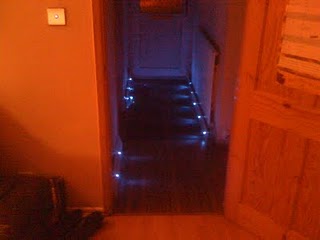If normal hallway lighting just doesn’t live up to your standards, this hack may be for you. When [Sean] fitted his kitchen, he replaced the flooring leading up to it. In true hacker form, he decided to forgo (supplement?) traditional lighting and came up with his own solution.
This solution involved embedding the skirting used around his hallway hardwood with blue LED lights. Unfortunately, these LEDs were actually longer than the skirting was thick, so some plaster carving was also necessary. It is all hidden very well behind the skirting, so you can’t tell. These blue LEDs give a really cool effect, similar to what can be seen at some movie theaters.
Although impressive in itself, [Sean] decided to also hook his setup up to a “Home Easy” device for control. A passive infrared sensor for this system has also been ordered so the lights can turn on without human interaction. We can see this being fantastic for those late night trips to the kitchen for a drink. With this low light solution, you won’t be wondering back to the bedroom without your night vision.
















LEDs are always nice. Not that he needed anything else for this project, but if the LEDs were all home wired individually you could add effects like chasing and cascading.
Should use a narrow angle infrared IRLED and photo-transistor combo for the trip wire. paired with a Uc and transistor/ mosfet to drive LED’s and create effects.
Is it just me, or does it look a bit tacky to use LEDs like this?
It always reminds me of the bar in a cheap holiday cruise ship with the tiny spots of light on the staircases to make it seem more “70’s disco” than it should?
I think it might look better if you instead put a small gap or a groove to the baseboard and let the light shine out of it, spread more evenly.
nice idea – I had the same thought long ago, so that I wouldn’t need to turn on lights when I got up in the middle of the night. But blue LEDs? Of all the color LEDs available, blue has to be the most unfriendly and emotionally cold. Blue LEDs started appearing on everything ten years ago when they could finally manufacture them properly (ie ‘Because they could’), but thankfully this fad has changed and we get good old green and red again. But personally, give me warm white LEDs anyday.
Also, warm lights are more suitable for low levels of illumination, because while stark blue light may look cool and you can sense it at lower intensities, it tends to bleach the rhodopsin in the eye.
Rhodopsin is responsible for low-light vision, and it’s the fourth primary color that we can sense, appearing kinda like purple, but it only works if there’s very little light. It’s the twilight color.
@Mr. Name Required
I don’t know, I /like/ the cool blue. You can’t tell from this picture, but I wouldn’t want them too bright. They would need to provide a small amount of illumination, but not so much as to kill any low-light vision you have. Being as they can be seen fairly well with the normal lights on, I think these would be too bright for my personal liking.
It is worth noting that red rather than blue should be used since blue light resets your circadian rhythm.
cool, haz leds
>blue light resets your circadian rhythm
Garbage, not at this intensity
“…you won’t be wAndering back to the bedroom…”
Jesus, I’m not even a native english speaker.
I would have gone with red to preserve night vision…
I’ve got to admit, this post was quite well-written, except for the “wondering” at the end – a simple typo that spell-check won’t catch.
Interesting idea. I would’ve rather used a diffused acrylic trim that would fan out the LED’s glow. As Dax said, I, too, think they look a tad tacky.
@mixadj
On that note, better to use a simple uC to control the lights via PWM and make them pulse softly at night, as with a bunker. :)
Me. I’m wondering why they cut a channel into the plaster to make room for the wiring, rather than cut the channel into the back of the mop boards?
I’m not a native English speaker either, but the words ‘wondering’ and ‘wandering’ mean completely different things, and it irked me too. Take the crit in stride, and just learn from it, dude. :)
Nice idea this. Plenty could be done in terms of animation, to make it look even cooler. And I agree on the warm glow beating harsh points of light.